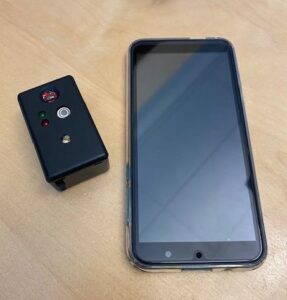
A portable rapid COVID-19 test being developed by University of Utah electrical and computer engineering professor Massood Tabib-Azar was selected as one of 10 finalists in the XPRIZE Rapid Covid Testing prize in the Open Innovation Track. The competition, conducted by the non-profit XPRIZE Foundation, is designed to create newer, higher standards of COVID-19 testing.
Tabib-Azar’s rapid test involves a small electronic device with a series of sensors that can pair with a smartphone. The user can either breathe on the sensor or deposit a drop of saliva. If the COVID virus is in the sample, it changes the electrical properties of the materials in the sensor and displays a red LED light, indicating the user has the virus. A negative result would display a green light. The test result takes less than one minute, much faster than the current Abbott COVID-19 rapid test, which takes about 15 minutes.
The device can also be used with a smartphone and app being developed by Tabib-Azar’s team that can – with the user’s permission – upload the test results to a central server. A map on the app can display where and when other users have tested positive.
“Imagine everyone has this on their cell phone, you can correlate with others who have tested positive and come up with a map that shows the density of the virus,” Tabib-Azar said.
The current prototype, which is about the size of car key fob (researchers hope to get it to the approximate size of a quarter), also contains an oximeter to measure the user’s blood oxygen levels and a thermometer to register body temperature. Both tests are performed by pressing a finger on each of two sensors. These additional health measurements can help determine if the person also has a fever and is experiencing breathing problems, two well-known symptoms of the virus. The user can then clean and clear the device for another use by just adding droplets of hot water on the sensor, which destroys any remnants of the virus from a previous test, Tabib-Azar said.
“My plan for this is that it gives you a complete picture of not only your state of infection but also the stage of the infection,” he said.
Currently, Tabib-Azar is working to improve the accuracy of the test, which now produces about 5% to 6% false positives and 5% to 6% false negatives.
According to the competition, “At the discretion of the judging panel, top teams in this track will be eligible to win a share of $500,000. These teams may choose to perform testing at a deployment site and upon successful completion are eligible to share an additional award of up to $500,000.”
The competition for the winner will be held later this month, Tabib-Azar said.
This prize comes out of the XPRIZE Pandemic Alliance, which was launched “as a response to COVID-19 to bring researchers, innovators, institutions, corporations, and governments together to share ideas and resources in the fight against the current and future pandemics,” according to the group.